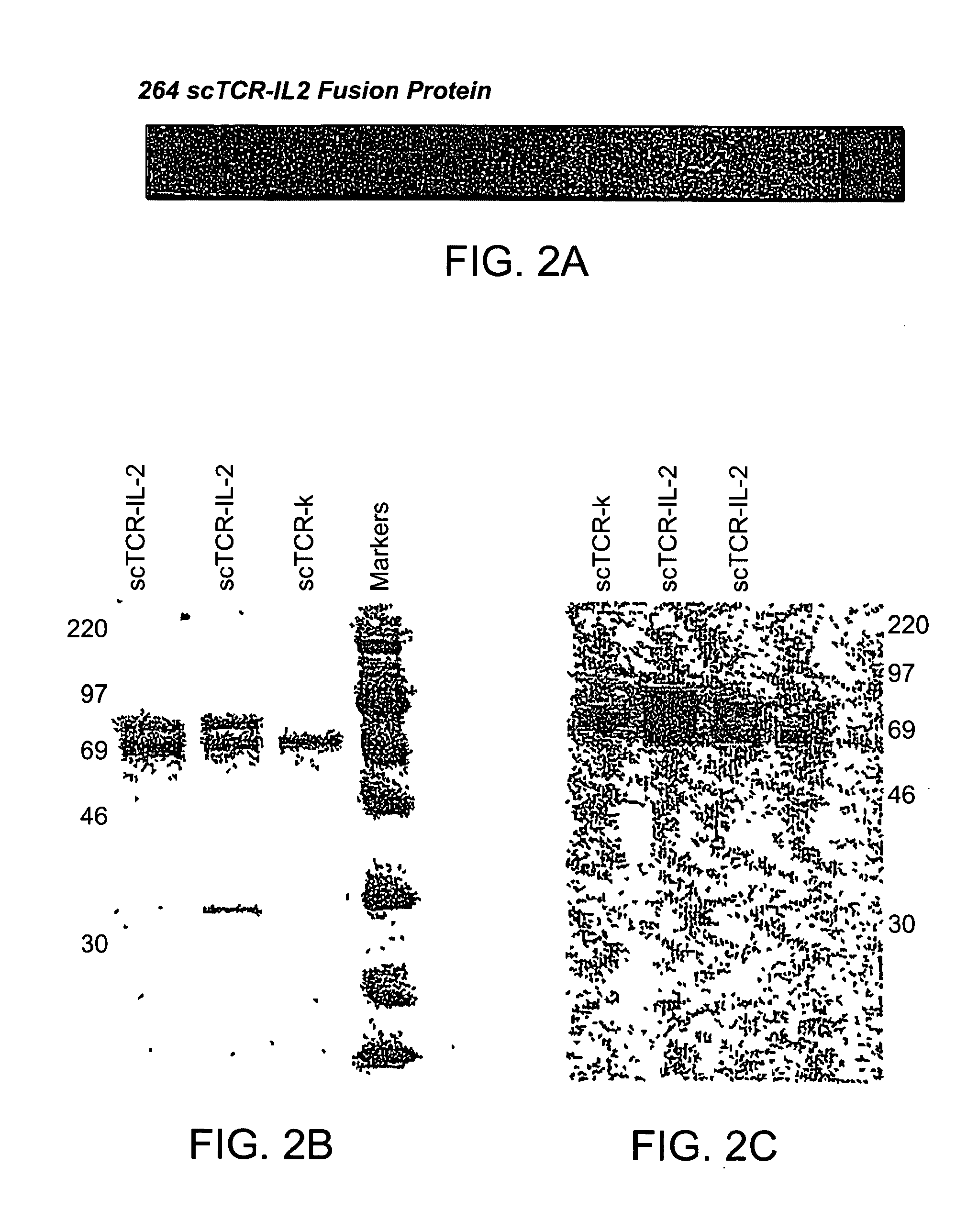T cell receptor fusions and conjugates and methods of use there of
a technology of t cell receptor and conjugate, which is applied in the field of soluble t cell receptor fusion complexes and soluble t cell receptor conjugate complexes, can solve the problems of rhil-2 having a very short half life, not proven effective therapies against a majority of these indications, and limited therapeutic use of cytokines
- Summary
- Abstract
- Description
- Claims
- Application Information
AI Technical Summary
Benefits of technology
Problems solved by technology
Method used
Image
Examples
example 1
Construction of 264 Single-Chain (sc) TCR
[0152]The T cell clone, 264, recognizes a peptide fragment (aa 264-272; LLGRNSFEV) of the human wild-type tumor suppresser protein p53 restricted by HLA-A2.1. The T cell receptor gene was cloned into a three domain single-chain format previously shown to produce soluble TCR and functional receptor molecules.
[0153]In brief, mRNA was isolated from the T cell clone and cDNA was made using the Marathon cDNA Amplification Kit (Clontech). Sequencing of cDNA clones identified two distinct V alpha chains (Valpha 3 and V alpha 13) and a single V beta chain (V beta 3). The cDNA was used as a template in polymerase chain reaction (PCR) with primers KC228 and KC229 or KC226 and KC227 to produce 5′Sfil-3′Spel V alpha 3 or V alpha 13 fragments respectively. The same DNA was then used as a PCR template with primers PRIB4 and KC176 to generate a 5′XhoI-3′XmaI V beta C beta chain fragment. The C beta chain was truncated just before the cysteine residue at ami...
example 2
Construction of the CD3 Zeta Fusion Vector
[0157]To determine which of the two V alpha chains was functional, both the 264-A and 264-B scTCR were expressed as CD3 zeta fusion molecules.
[0158]Construction of a shuttle vector has been previously described in pending U.S. application Ser. No. 09 / 422,375.
[0159]Briefly, alpha and beta chain TCR fragments were cloned into the into the expression vector pKC60 to create a V alpha-(G4 S)4 V beta C beta scTCR molecule. The new vector was named pNAG2 (FIG. 9). pNAG2 was then reamplified by PCR with primers KC203 and KC208 to generate a 5′AgeI-3′HpaI / BspEI / NruI / ClaI DNA fragment. The scTCR fragment was cloned into the pGEM-T Easy Vector System and this new pGEM-based vector was then used as a “shuttle vector” for introduction of other DNA fragments to create a bispecific sc molecule.
[0160]Sc-Fv DNA was then restriction digested and cloned into the “shuttle vector” downstream of the scTCR. To connect the scTCR and scSc-Fv together as a single-cha...
example 3
Expression of 264 scTCR / CD3 Zeta Fusion Molecules
[0166]Jurkat cells were prepared for transfection by washing with cold DPBS. The cells were resuspended in DPBS and mixed with 20 ug of PvuI linearized 264-A / CD3 zeta or 264-B / CD3 zeta DNA. After five minutes on ice, the cells were electroporated using a Gene Pulser (BioRad) set to deliver one pulse of 250 volts, 960 u Fd or 0.25 u Fd. The pulsed cells were placed on ice for five minutes. The cells were diluted into 10 ml of 10% IMDM medium (IMDM, 10% FBS, 2 mM glutamine) and grown in a T-25 cm2TC flask overnight at 37 C with 5% CO2. The next day, the cells were plated in 96 well plates with selective medium (10% IMDM plus 1.0 mg / ml G418). After 1 week, the concentration of G418 was increased to 2 mg / ml. The growing colonies were refed approximately two weeks after transfection and screened about one week later.
[0167]The transfected Jurkat cells were screened for surface expression of scTCR using flow cytometry analysis. Positive tran...
PUM
| Property | Measurement | Unit |
|---|---|---|
| temperature | aaaaa | aaaaa |
| ionic strength | aaaaa | aaaaa |
| ionic strength | aaaaa | aaaaa |
Abstract
Description
Claims
Application Information
 Login to View More
Login to View More - R&D
- Intellectual Property
- Life Sciences
- Materials
- Tech Scout
- Unparalleled Data Quality
- Higher Quality Content
- 60% Fewer Hallucinations
Browse by: Latest US Patents, China's latest patents, Technical Efficacy Thesaurus, Application Domain, Technology Topic, Popular Technical Reports.
© 2025 PatSnap. All rights reserved.Legal|Privacy policy|Modern Slavery Act Transparency Statement|Sitemap|About US| Contact US: help@patsnap.com



